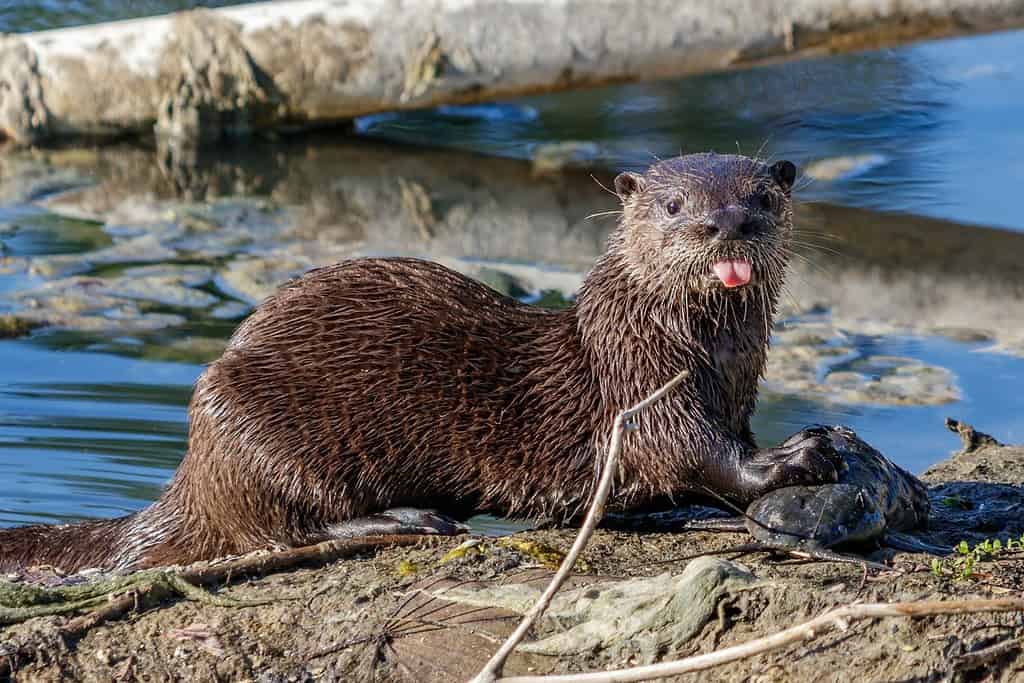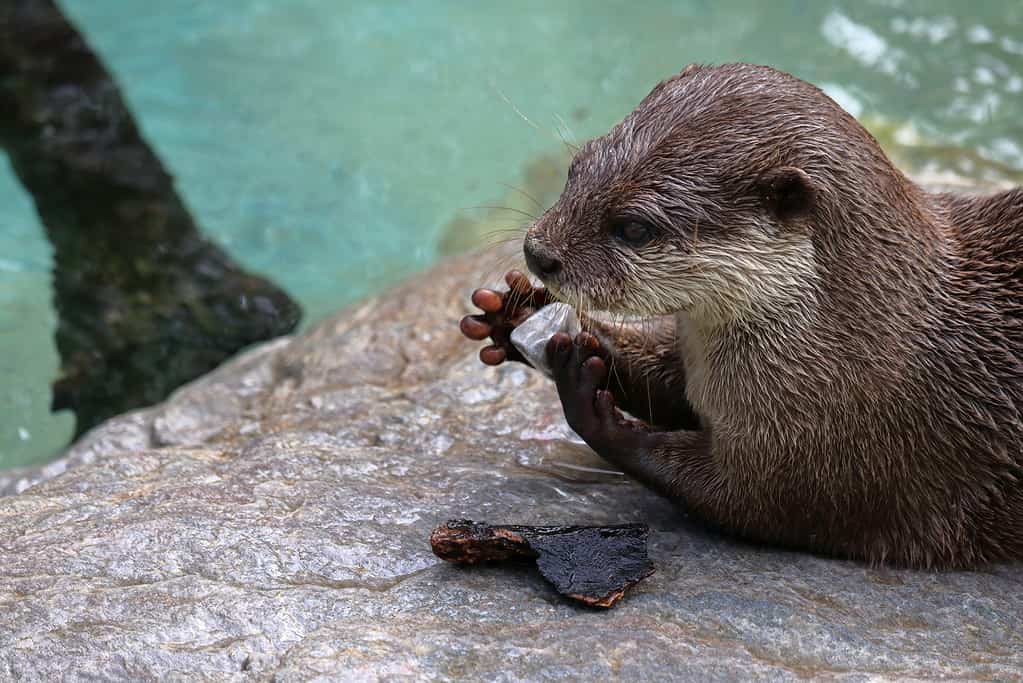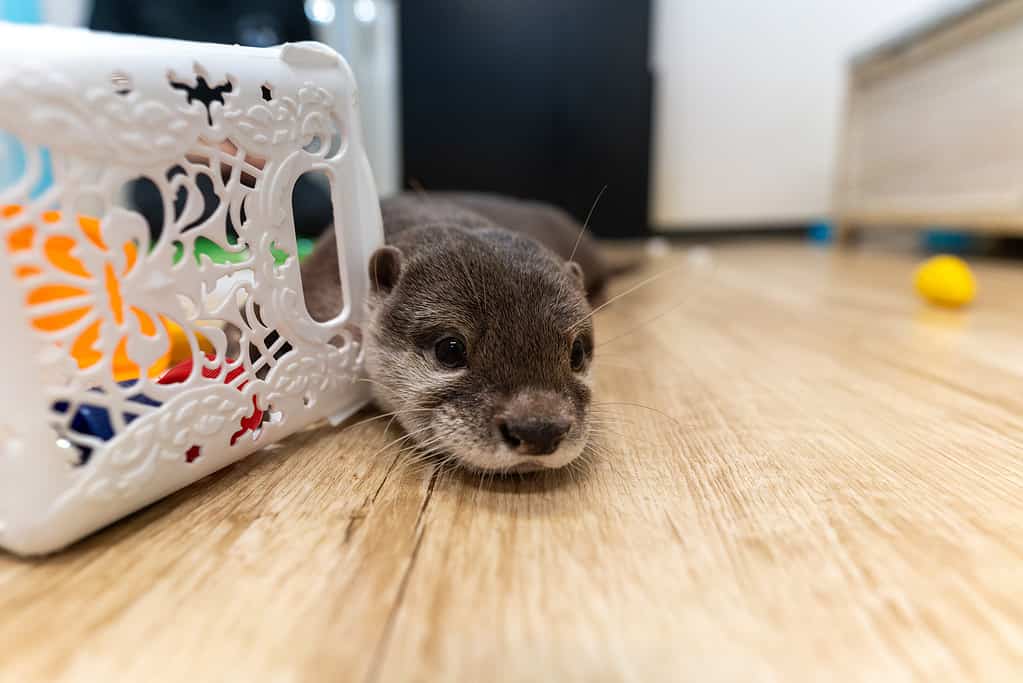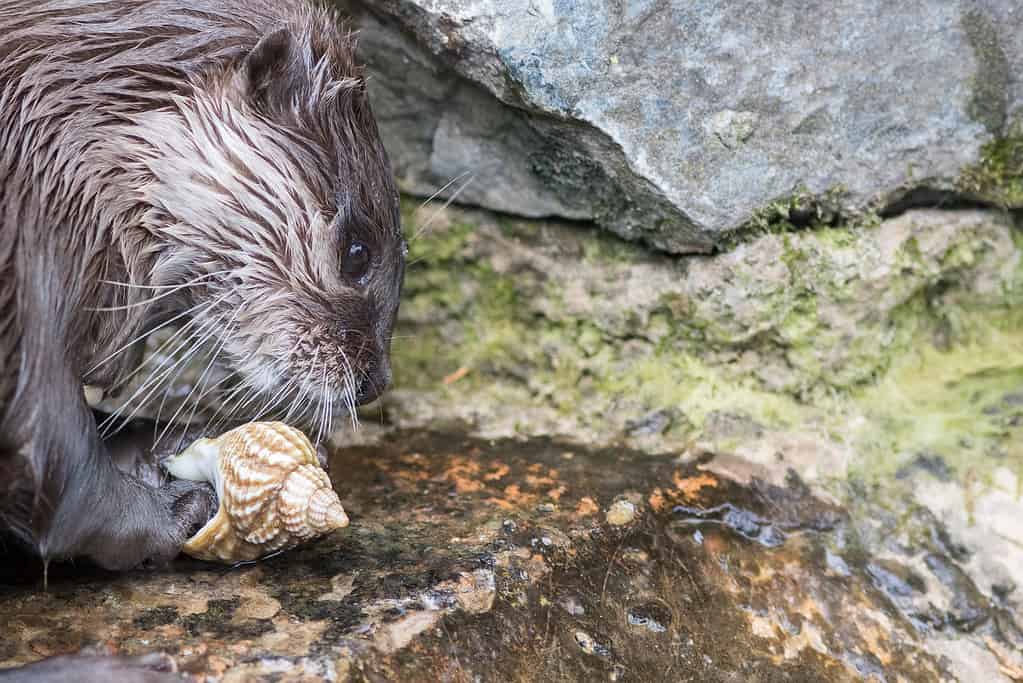
Sea otters mate for life and develop strong family bonds with their cubs and romp (group of otters).
©Laura Hedien/Shutterstock.com
Otters are adorable water mammals that are easily recognizable for their cute faces, habit of floating on their back, and ability to use tools for food. Interestingly, otters are proving more intelligent than researchers previously believed.
This article breaks down basic otter facts, their intelligence level, and how their intellect is measured.
The Basics on Otters

Interestingly, sea otters are heavier and possibly smarter than wolverines.
©Microfile.org/Shutterstock.com
Sea otters are the largest member of the otter family. These sea mammals weigh between 31-99 pounds and can live up to 10-20 years in the wild. The oldest sea otter lived to the age of 25, but that was with immediate veterinary care and a healthy atmosphere.
Sea otters sustain their large bodies by eating urchins, crabs, mussels, fish, and small octopuses on occasion.
Measuring Otter Intelligence

These animals analyze several rocks to determine which one is better for their shell-cracking needs.
©mitumal/iStock via Getty Images
Otters do not have a standard IQ like humans, because they are not capable of taking tests or learning information the way humans can. Instead, otter intelligence is measured by how well they can learn, comprehend, and process commands. Their curiosity and ability to understand foreign objects also contribute to their overall intelligence.
How Smart Are Otters?
Scientists are proving that otters (especially sea otters) are one of the smartest marine mammals in the world. Their overall intelligence and curiosity rivals that of dolphins who are widely regarded as the smartest marine mammal.
Otters Use Tools

Otters love fidgeting with stones and carry around their favorite stone until it is blunt.
©Andrew Stark/iStock via Getty Images
The first clear evidence of the intelligence of otters is their ability to use tools. Tool use is a large indicator that the animal is capable of problem-solving by using other objects to find a solution.
Otters use hard surfaces or rocks as anvils to break open the shells of clams and mussels to get the meat inside. They may place the rock flat on their stomach while they float on the water. Once they find a shell, they go on land and use the rock to smash it open.
Additionally, otters recognize certain rocks as better than others and carry their favorite rock with them for future meals. When the rock is no longer sharp enough, they replace it with another. This clearly shows they are capable of identifying objects suitable for their needs.
Otters Have Clever Families

Weasels are synonymous with inquisitive behavior and being clever, attributes of high mental activity.
©ilyasov/iStock via Getty Images
Otters are part of the Mustelidae family, making them close relatives of weasels, stoats, ferrets, badgers, and wolverines. A common trait with all of these animals is their highly inquisitive personalities. They love to fiddle with everything around them. These animals naturally try to understand their environment and play with objects to learn how they can use them to their advantage.
Ferret owners are well aware that ferrets steal objects and hide them in their dens to play with later. Otters share that curious nature and seek out anything to stimulate their minds.
The phrases “ferreting for information” or “weasel out the truth” are synonymous with using intelligence and curiosity to find answers to a problem.
Learning Comprehension

Otters need plenty of toys to keep them occupied.
©GarethDaBell/iStock via Getty Images
A large contributor to understanding otter intelligence is their ability to learn and successfully follow commands. Zoo and aquarium staff can teach otters to perform simple tricks through a combination of positive reinforcement and simple commands like come, stop, up, scale, and spin.
Otter trainers nurture their innate curiosity with flavorful treats to test how well they learn basic commands and follow instructions. The faster the otters perform the trick with a high success rate, the higher their intelligence levels.
However, some otters may not be as receptive to commands because of their individual personalities. But their inability to follow commands may indicate a preference for playing with toys and objects on their own.
Environmental Understanding

Domestic otters can be very destructive because they do not obey human commands easily.
©exs/iStock via Getty Images
Otters have an innate desire to understand and manipulate things around them. This can cause a problem for domestic otter owners because these animals will destroy the house without proper guidance.
Left alone with little mental stimulation, otters will seek out objects to occupy their mind. This may lead to them stealing tools, shoes, or phones and smashing them against each other. If they find an object they cannot break, they will seek out another object to break it to see what is inside.
This highly destructive behavior is curbed when they are constantly mentally engaged, indicating they have higher mental activity than other animals who prefer to sleep constantly or are subject to their base instincts of hunting and chasing prey.
Final Verdict

Otters analyze shells closely to find weak points so they can break them open more easily.
©Ian Dyball/iStock via Getty Images
Overall, otters are highly intelligent animals that are capable of successful problem solving and object identification. These animals are trainable with proper motivation and consistency.
The fact they actively seek objects to occupy their mind shows a naturally high level of mental activity. When their minds are not stimulated enough, they find ways to entertain themselves.
The photo featured at the top of this post is © Ian Dyball/iStock via Getty Images
Thank you for reading! Have some feedback for us? Contact the AZ Animals editorial team.







